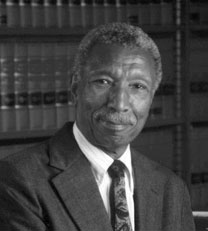
Thoroughgood "Thurgood" Marshall was an American civil rights lawyer and jurist who served as an associate justice of the Supreme Court of the United States from 1967 until 1991. He was the Supreme Court's first African-American justice. Prior to his judicial service, he was an attorney who fought for civil rights, leading the NAACP Legal Defense and Educational Fund. Marshall was a prominent figure in the movement to end racial segregation in American public schools. He won 29 of the 32 civil rights cases he argued before the Supreme Court, culminating in the Court's landmark 1954 decision in Brown v. Board of Education, which rejected the separate but equal doctrine and held segregation in public education to be unconstitutional. President Lyndon B. Johnson appointed Marshall to the Supreme Court in 1967. A staunch liberal, he frequently dissented as the Court became increasingly conservative.
Brown v. Board of Education of Topeka, 347 U.S. 483 (1954), was a landmark decision of the U.S. Supreme Court that ruled that U.S. state laws establishing racial segregation in public schools are unconstitutional, even if the segregated schools are otherwise equal in quality. The decision partially overruled the Court's 1896 decision Plessy v. Ferguson, which had held that racial segregation laws did not violate the U.S. Constitution as long as the facilities for each race were equal in quality, a doctrine that had come to be known as "separate but equal". The Court's unanimous decision in Brown, and its related cases, paved the way for integration and was a major victory of the civil rights movement, and a model for many future impact litigation cases.
Separate but equal was a legal doctrine in United States constitutional law, according to which racial segregation did not necessarily violate the Fourteenth Amendment to the United States Constitution, which nominally guaranteed "equal protection" under the law to all people. Under the doctrine, as long as the facilities provided to each race were equal, state and local governments could require that services, facilities, public accommodations, housing, medical care, education, employment, and transportation be segregated by race, which was already the case throughout the states of the former Confederacy. The phrase was derived from a Louisiana law of 1890, although the law actually used the phrase "equal but separate".
Sweatt v. Painter, 339 U.S. 629 (1950), was a U.S. Supreme Court case that successfully challenged the "separate but equal" doctrine of racial segregation established by the 1896 case Plessy v. Ferguson. The case was influential in the landmark case of Brown v. Board of Education four years later.
Boynton v. Virginia, 364 U.S. 454 (1960), was a landmark decision of the US Supreme Court. The case overturned a judgment convicting an African American law student for trespassing by being in a restaurant in a bus terminal which was "whites only". It held that racial segregation in public transportation was illegal because such segregation violated the Interstate Commerce Act, which broadly forbade discrimination in interstate passenger transportation. It moreover held that bus transportation was sufficiently related to interstate commerce to allow the United States federal government to regulate it to forbid racial discrimination in the industry.

Charles Hamilton Houston was an American lawyer. He was the dean of Howard University Law School and NAACP first special counsel. A graduate of Amherst College and Harvard Law School, Houston played a significant role in dismantling Jim Crow laws, especially attacking segregation in schools and racial housing covenants. He earned the title "The Man Who Killed Jim Crow".
Briggs v. Elliott, 342 U.S. 350 (1952), on appeal from the U.S. District Court for the Eastern District of South Carolina, challenged school segregation in Summerton, South Carolina. It was the first of the five cases combined into Brown v. Board of Education (1954), the famous case in which the U.S. Supreme Court declared racial segregation in public schools to be unconstitutional by violating the Fourteenth Amendment's Equal Protection Clause. Following the Brown decision, the district court issued a decree that struck down the school segregation law in South Carolina as unconstitutional and required the state's schools to integrate. Harry and Eliza Briggs, Reverend Joseph A. DeLaine, and Levi Pearson were awarded Congressional Gold Medals posthumously in 2003.
The Equal Protection Clause is part of the first section of the Fourteenth Amendment to the United States Constitution. The clause, which took effect in 1868, provides "nor shall any State ... deny to any person within its jurisdiction the equal protection of the laws." It mandates that individuals in similar situations be treated equally by the law.

The NAACP Legal Defense and Educational Fund, Inc. is an American civil rights organization and law firm based in New York City.

The Warren Court was the period in the history of the Supreme Court of the United States from 1953 to 1969 when Earl Warren served as the chief justice. The Warren Court is often considered the most liberal court in U.S. history.

Robert Lee Carter was an American lawyer, civil rights activist and a United States district judge of the United States District Court for the Southern District of New York.
Browder v. Gayle, 142 F. Supp. 707 (1956), was a landmark federal court case that ruled that segregation on public transportation was unconstitutional. The case was heard before a three-judge panel of the United States District Court for the Middle District of Alabama on the segregation of Montgomery and Alabama state buses. The panel consisted of Middle District of Alabama Judge Frank Minis Johnson, Northern District of Alabama Judge Seybourn Harris Lynne, and Fifth Circuit Court of Appeals Judge Richard Rives. The main plaintiffs in the case were Aurelia Browder, Claudette Colvin, Susie McDonald, and Mary Louise Smith. Their attorney, Fred Gray, also approached Jeanetta Reese to join the suit, but intimidation by segregationists caused her to withdraw.
Cooper v. Aaron, 358 U.S. 1 (1958), was a landmark decision of the Supreme Court of the United States that denied the school board of Little Rock, Arkansas the right to delay racial desegregation for 30 months. On September 12, 1958, the Warren Court delivered a decision that held that the states are bound by the Court's decisions and must enforce them even if the states disagree with them, asserting the judicial supremacy established in Marbury v. Madison (1803). The decision in this case upheld the rulings in Brown v. Board of Education and Brown II that had held that the doctrine of separate but equal was unconstitutional.
Murray v. Pearson was a Maryland Court of Appeals decision which found "the state has undertaken the function of education in the law, but has omitted students of one race from the only adequate provision made for it, and omitted them solely because of their color." On January 15, 1936, the court affirmed the lower court ruling which ordered the university to immediately integrate its student population, and therefore created a legal precedent making segregation in Maryland illegal.

Alexander Pierre "A. P." Tureaud Sr. was an African-American attorney who headed the legal team for the New Orleans chapter of the NAACP during the Civil Rights Movement. With the assistance of Thurgood Marshall and Robert Carter from the NAACP Legal Defense and Educational Fund, A. P. Tureaud filed the lawsuit that successfully ended the system of Jim Crow segregation in New Orleans. That case paved the way for integrating the first two elementary schools in the Deep South.
Griffin v. County School Board of Prince Edward County, 377 U.S. 218 (1964), is a case decided by the Supreme Court of the United States that held that the County School Board of Prince Edward County, Virginia's decision to close all local, public schools and provide vouchers to attend private schools were constitutionally impermissible as violations of the Equal Protection Clause of the Fourteenth Amendment.
Desegregation of the Baltimore City Public Schools took place in 1956 after the United States Supreme Court ruled, in the case of Brown v. Board of Education, that segregation in schools went against constitutional law. Desegregation of U.S. schools was part of the civil rights movement. The events that followed desegregation in Baltimore, were important to the civil rights movement across America. Recent scholarship has identified Baltimore's desegregation as an important precursor to the Greensboro sit-ins.

Sarah Keys v. Carolina Coach Company, 64 MCC 769 (1955) is a landmark civil rights case in the United States in which the Interstate Commerce Commission, in response to a bus segregation complaint filed in 1953 by a Women's Army Corps (WAC) private named Sarah Louise Keys, broke with its historic adherence to the Plessy v. Ferguson separate but equal doctrine and interpreted the non-discrimination language of the Interstate Commerce Act of 1887 as banning the segregation of black passengers in buses traveling across state lines.
June Shagaloff Alexander was an American civil rights activist.
NAACP v. Button, 371 U.S. 415 (1963), is a ruling by the Supreme Court of the United States which held that the reservation of jurisdiction by a federal district court did not bar the U.S. Supreme Court from reviewing a state court's ruling, and also overturned certain laws enacted by the state of Virginia in 1956 as part of the Stanley Plan and massive resistance, as violating the First and Fourteenth Amendments to the United States Constitution. The statutes struck down by the Supreme Court had expanded the definitions of the traditional common law crimes of champerty and maintenance, as well as barratry, and had been targeted at the NAACP and its civil rights litigation.







